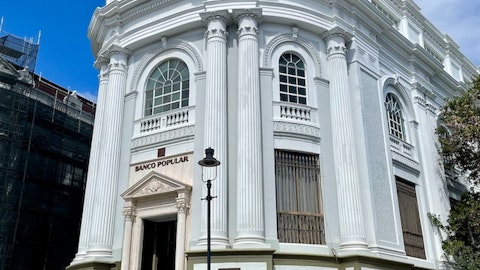But there’s a number of those projects that has been awarded this year. We’re involved in 11 of those. So we should see that activity pick up next year. Again, it takes permitting whatever but those projects have not been awarded. So I think you’re going to continue to see the basic infrastructure, energy, highway, water. And I think you’re going to beginning to see housing pickup next year.
Carlos Vazquez: Keep in mind, Alex, that probably more than half of this balance is the actual operating accounts of those 100 plus or almost 200 clients. So there’s always going to be a given balance there that a normal course of business will never go away. So there is that, which is what we’ll always see there, there’s the amounts that are earmarked to different projects. There are a whole bunch of different things in different accounts for different purposes. So it is positive that the government has more cash on hand. But it will probably be an understatement to think it’s anywhere close to $18 billion. It’s a fraction of that.
Alexander Twerdahl: Okay. That’s great. And then just expanding on the 11 projects and some of the other things that Ignacio, you’re just mentioning, does that result in a larger level of construction disbursements for Popular next year that could help to drive loan balances higher?
Ignacio Alvarez: Yes. Definitely, I think there should be the residential construction, which has been kind of limited that should — there should be a pickup on that from those projects. Again, it begins, it depends when actually great ground and they start disbursement. Again, those products unfortunately, will not last for long on our balance sheet because the way it happens is the developer builds the homes and the government takes them out. So instead of the takeout coming from individual buyers, the government takes them out. But yes, in the short run, there should be an increase, especially in the residential construction. Again, apart from the government P.R. We’re seeing low-income tax credits also stimulating certain developments for elderly, especially in Puerto Rico and for all local income housing. So it’s not only P.R. There’s a number of projects that are gaining momentum. And I think we should see some of that next year.
Alexander Twerdahl: Great. And then is it fair to assume that mortgage that’s been growing for a couple of quarters, is that expected to continue? Just given that obviously, where rates are?
Ignacio Alvarez: Yes. Well, that’s a question I ask, obviously. We’ve seen some pickup in the purchase activity, but you’re right. I mean I think we’ve got to expect that the higher interest rates will have some impact on that. I mean that’s just basic logic. So a lot of the activity as we said in the prepared remarks, is purchase activity. So that’s going to have to be impacted.
Alexander Twerdahl: And then final question on loan growth. Are you guys willing to disclose how much of the highway loan you guys will take down?
Ignacio Alvarez: Yes, I think we are good. It’s been saying out that — we are — I can tell you this, the highway deal is a very important deal to look at from various perspectives. One, I think it shows a lot of confidence in Puerto Rico in the sense that you’re talking about a 40-year concession. And you had a — this is the largest project that Abertis, the Spanish company has done in the last 15 years, and the second largest project they’ve done in the history of the company. The syndicated banks that came in was a syndicate international banks, including major Japanese banks will have invested in Puerto Rico projects, I think, in a while. We took the — we shared the top lead bank role with one of those large Japanese banks.
And we will be disbursing — closing approximately $240 million and there’s another commitment for $60 million going forward for capital improvement and working capital in the future. So our total commitment is around $300 million but at closing, we’ll be discussing $240 million.
Alexander Twerdahl: Great. Thanks for taking my questions.
Operator: Our next question comes from Brody Preston of UBS. Brody, please go ahead.
Broderick Preston: Hey, good morning everyone.
Ignacio Alvarez: Good morning, Brody.
Carlos Vazquez: Good morning.
Broderick Preston: I wanted to ask just a follow-up on the government deposits. Did I hear you right, Carlos, do you say you expect those — the cost of those to increase by 10 basis points in the fourth quarter?
Carlos Vazquez: You heard me right. That’s our estimate, yes.
Broderick Preston: Okay. Great. And so what is the extra $2 billion of balances sticking around do in terms of NII enhancements relative to — if that — if the $2 billion was not — if the additional $2 billion was not going to be sticking around? Like what’s the extra NII dollars you get from that?
Carlos Vazquez: Well, we will disclose that formula, Brody, you got to have to go with your estimate of what the margin on that business is, I want to buy like $2 billion because we — as you know, we never disclose a specific what we have of the margin in that business. But it should be — if in fact, the balances end up at the high end of our updated range it should contribute to NII, yes.
Broderick Preston: All right. You’re too quick. I was trying to catch on your feet. I did notice that the commercial beta ticked down on the chart that you disclosed, and it looks like it was driven by the U.S. business with that beta taking down from 45% cycle to date to 36% cycle to date as of 3Q. And I wanted to ask if there was something specific that drove that like a higher balance kind of account leaving that was maybe costly, just looking for some color there?




